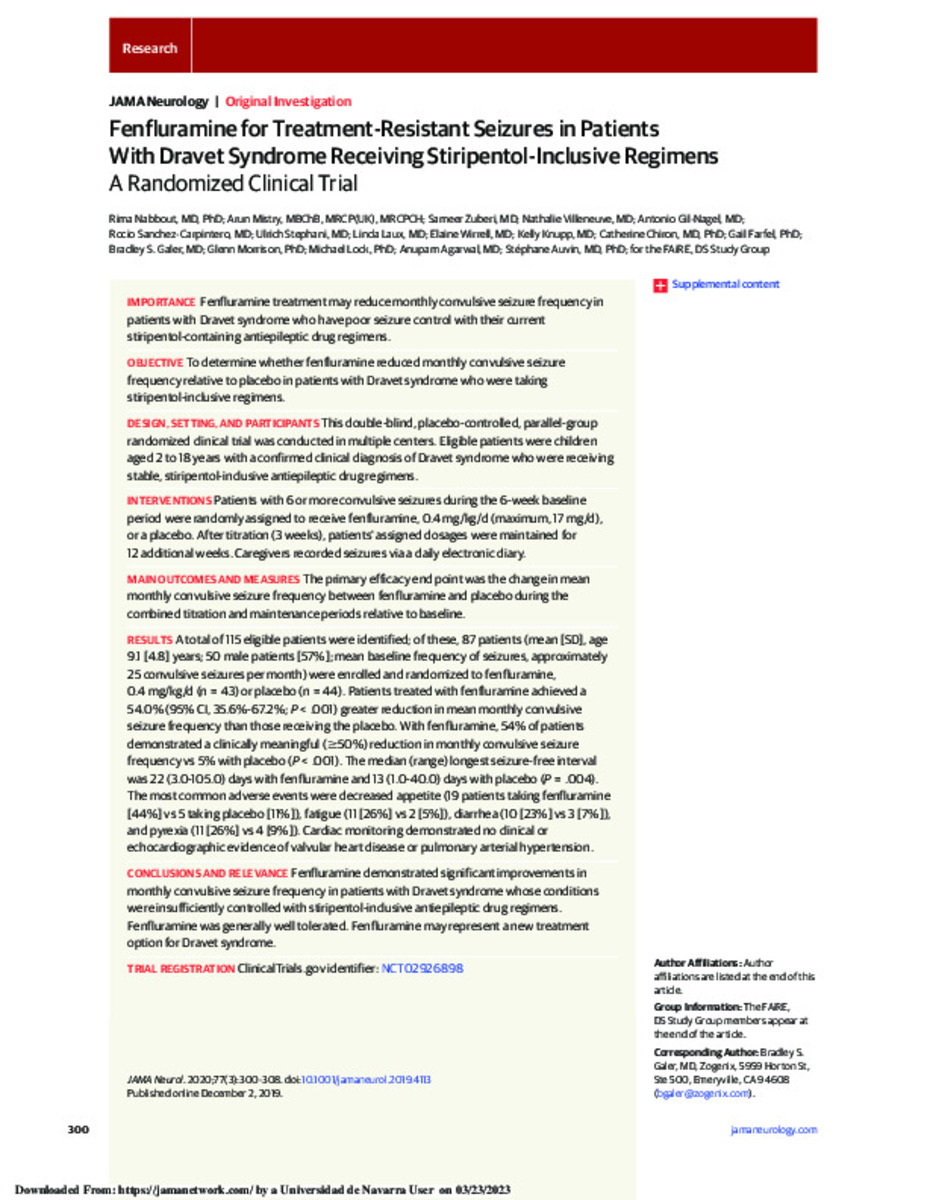Full metadata record
| DC Field | Value | Language |
|---|---|---|
| dc.creator | Nabbout, R. (Rima) | - |
| dc.creator | Mistry, A. (Arun) | - |
| dc.creator | Zuberi, S. (Sameer) | - |
| dc.creator | Villeneuve, N. (Nathalie) | - |
| dc.creator | Perry, M.S. (M. Scott) | - |
| dc.creator | Sanchez-Carpintero, R. (Rocío) | - |
| dc.creator | Stephani, U. (Ulrich) | - |
| dc.creator | Laux, L. (Linda) | - |
| dc.creator | Wirrell, E. (Elaine) | - |
| dc.creator | Knupp, K. (Kelly) | - |
| dc.creator | Chiron, C. (Catherine) | - |
| dc.creator | Farfel, G. (Gail) | - |
| dc.creator | Galer, B.S. (Bradley S.) | - |
| dc.creator | Morrison, G. (Glenn) | - |
| dc.creator | Lock, M. (Michael) | - |
| dc.creator | Agarwal, A. (Anupam) | - |
| dc.creator | Auvin, S. (Stéphane) | - |
| dc.date.accessioned | 2023-05-17T07:17:37Z | - |
| dc.date.available | 2023-05-17T07:17:37Z | - |
| dc.date.issued | 2020 | - |
| dc.identifier.citation | Nabbout, R. (Rima); Mistry, A. (Arun); Zuberi, S. (Sameer); et al. "Fenfluramine for Treatment-Resistant Seizures in Patients With Dravet Syndrome Receiving Stiripentol-Inclusive Regimens A Randomized Clinical Trial". JAMA Neurology. 77 (3), 2020, 300 - 308 | es_ES |
| dc.identifier.issn | 2168-6149 | - |
| dc.identifier.uri | https://hdl.handle.net/10171/66275 | - |
| dc.description.abstract | IMPORTANCE Fenfluramine treatment may reduce monthly convulsive seizure frequency in patients with Dravet syndrome who have poor seizure control with their current stiripentol-containing antiepileptic drug regimens. OBJECTIVE To determine whether fenfluramine reduced monthly convulsive seizure frequency relative to placebo in patients with Dravet syndrome who were taking stiripentol-inclusive regimens. DESIGN, SETTING, AND PARTICIPANTS This double-blind, placebo-controlled, parallel-group randomized clinical trial was conducted in multiple centers. Eligible patients were children aged 2 to 18 years with a confirmed clinical diagnosis of Dravet syndrome who were receiving stable, stiripentol-inclusive antiepileptic drug regimens. INTERVENTIONS Patients with 6 or more convulsive seizures during the 6-week baseline period were randomly assigned to receive fenfluramine, 0.4 mg/kg/d (maximum, 17 mg/d), or a placebo. After titration (3 weeks), patients’ assigned dosages were maintained for 12 additional weeks. Caregivers recorded seizures via a daily electronic diary. MAIN OUTCOMES AND MEASURES The primary efficacy end point was the change in mean monthly convulsive seizure frequency between fenfluramine and placebo during the combined titration and maintenance periods relative to baseline. RESULTS A total of 115 eligible patients were identified; of these, 87 patients (mean [SD], age 9.1 [4.8] years; 50 male patients [57%]; mean baseline frequency of seizures, approximately 25 convulsive seizures per month) were enrolled and randomized to fenfluramine, 0.4 mg/kg/d (n = 43) or placebo (n = 44). Patients treated with fenfluramine achieved a 54.0% (95% CI, 35.6%-67.2%; P < .001) greater reduction in mean monthly convulsive seizure frequency than those receiving the placebo. With fenfluramine, 54% of patients demonstrated a clinically meaningful (50%) reduction in monthly convulsive seizure frequency vs 5% with placebo (P < .001). The median (range) longest seizure-free interval was 22 (3.0-105.0) days with fenfluramine and 13 (1.0-40.0) days with placebo (P = .004). The most common adverse events were decreased appetite (19 patients taking fenfluramine [44%] vs 5 taking placebo [11%]), fatigue (11 [26%] vs 2 [5%]), diarrhea (10 [23%] vs 3 [7%]), and pyrexia (11 [26%] vs 4 [9%]). Cardiac monitoring demonstrated no clinical or echocardiographic evidence of valvular heart disease or pulmonary arterial hypertension. CONCLUSIONS AND RELEVANCE Fenfluramine demonstrated significant improvements in monthly convulsive seizure frequency in patients with Dravet syndrome whose conditions were insufficiently controlled with stiripentol-inclusive antiepileptic drug regimens. Fenfluramine was generally well tolerated. Fenfluramine may represent a new treatment option for Dravet syndrome. TRIAL REGISTRATION ClinicalTrials.gov identifier: NCT02926898 | es_ES |
| dc.description.sponsorship | This study was funded by Zogenix. Zogenix, in collaboration with study investigators and the contracted clinical research organizations (Premier Research and Syneos Health), were responsible for the design and conduct of the study; collection, management, analysis, and interpretation of the data; preparation, review, or approval of the manuscript; and decision to submit the manuscript for publication. | es_ES |
| dc.language.iso | eng | es_ES |
| dc.rights | info:eu-repo/semantics/openAccess | es_ES |
| dc.title | Fenfluramine for Treatment-Resistant Seizures in Patients With Dravet Syndrome Receiving Stiripentol-Inclusive Regimens A Randomized Clinical Trial | es_ES |
| dc.type | info:eu-repo/semantics/article | es_ES |
| dc.publisher.place | USA | es_ES |
| dc.description.note | This is an open access article distributed under the terms of the CC-BY-NC-ND License. | es_ES |
| dc.identifier.doi | 10.1001/jamaneurol.2019.4113 | - |
| dadun.citation.endingPage | 308 | es_ES |
| dadun.citation.number | 3 | es_ES |
| dadun.citation.publicationName | JAMA Neurology | es_ES |
| dadun.citation.startingPage | 300 | es_ES |
| dadun.citation.volume | 77 | es_ES |
Files in This Item:
Statistics and impact
Items in Dadun are protected by copyright, with all rights reserved, unless otherwise indicated.






